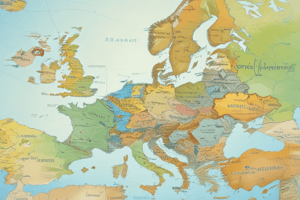Podcast
Questions and Answers
What is instrumentalization of migrants referring to in the context of the Schengen Area?
What is instrumentalization of migrants referring to in the context of the Schengen Area?
- Using countries' legal frameworks to enhance border security
- Enforcing stronger immigration laws within the EU
- Integrating migrants into the Schengen Area legally
- Exploiting the movement of migrants to influence EU policies (correct)
Which document resolved the conflict between the Schengen cooperation and the third pillar of the EU competences?
Which document resolved the conflict between the Schengen cooperation and the third pillar of the EU competences?
- The Schengen Borders Code
- The Amsterdam Treaty (correct)
- The Lisbon Treaty
- The Maastricht Treaty
How many states are currently part of the Schengen Area?
How many states are currently part of the Schengen Area?
- 31
- 25
- 27
- 29 (correct)
What legal basis was identified for the Schengen acquis within EU law?
What legal basis was identified for the Schengen acquis within EU law?
Which country is not part of the Schengen Area due to specific provisions?
Which country is not part of the Schengen Area due to specific provisions?
What is the status of Cyprus in relation to the Schengen Area?
What is the status of Cyprus in relation to the Schengen Area?
What changes are set to occur for Bulgaria and Romania regarding border controls on March 31, 2024?
What changes are set to occur for Bulgaria and Romania regarding border controls on March 31, 2024?
What does A21a of the SBC allow in response to large-scale public emergencies?
What does A21a of the SBC allow in response to large-scale public emergencies?
What type of checks were introduced for persons enjoying the right of free movement under Union Law after 2017?
What type of checks were introduced for persons enjoying the right of free movement under Union Law after 2017?
What is the requirement for 'Third Country Nationals' entering the EU according to A8(3)?
What is the requirement for 'Third Country Nationals' entering the EU according to A8(3)?
What is the main legislation that allows free movement between Schengen member states?
What is the main legislation that allows free movement between Schengen member states?
Which article of the Schengen Border Code defines internal and external borders?
Which article of the Schengen Border Code defines internal and external borders?
What is a potential reason for reintroducing border controls at internal borders according to the Schengen Border Code?
What is a potential reason for reintroducing border controls at internal borders according to the Schengen Border Code?
Which regulation established the Entry/Exit system for border checks?
Which regulation established the Entry/Exit system for border checks?
What does the term 'Schengen Acquis' refer to?
What does the term 'Schengen Acquis' refer to?
Which treaty incorporated the Schengen acquis into EU law?
Which treaty incorporated the Schengen acquis into EU law?
Which of the following is NOT a condition for valid entry according to the Schengen Border Code?
Which of the following is NOT a condition for valid entry according to the Schengen Border Code?
What is a characteristic of the 'associated states' within the Schengen area?
What is a characteristic of the 'associated states' within the Schengen area?
What is the maximum period for which a total period can be extended?
What is the maximum period for which a total period can be extended?
In emergency situations, how soon must notification be made?
In emergency situations, how soon must notification be made?
What does Article A29 pertain to?
What does Article A29 pertain to?
Which of the following periods did the Council of EU recommend controls every 6 months?
Which of the following periods did the Council of EU recommend controls every 6 months?
What was the outcome of the ECJ's decision in April 2022 regarding A25 use after 6 months?
What was the outcome of the ECJ's decision in April 2022 regarding A25 use after 6 months?
Which significant event influenced France's decision to extend controls during 2015?
Which significant event influenced France's decision to extend controls during 2015?
What did the Conseil d'état decide in December 2017 regarding state controls?
What did the Conseil d'état decide in December 2017 regarding state controls?
By 2023, how many member states still had controls in place?
By 2023, how many member states still had controls in place?
What is the purpose of the Schengen Information System as amended?
What is the purpose of the Schengen Information System as amended?
Which regulation is associated with the establishment of Eurodac?
Which regulation is associated with the establishment of Eurodac?
What does the Entry/Exit System record?
What does the Entry/Exit System record?
What is the primary aim of Frontex as per Regulation 2019/1896?
What is the primary aim of Frontex as per Regulation 2019/1896?
Which of the following is a condition for the temporary reintroduction of internal border controls?
Which of the following is a condition for the temporary reintroduction of internal border controls?
The Visa Information System has been extended to include which of the following?
The Visa Information System has been extended to include which of the following?
According to the amended provisions of the Schengen Borders Code, which article allows for checks within member states?
According to the amended provisions of the Schengen Borders Code, which article allows for checks within member states?
What does Regulation 2024/1358 accomplish in relation to Eurodac?
What does Regulation 2024/1358 accomplish in relation to Eurodac?
Flashcards
Schengen Cooperation
Schengen Cooperation
The Schengen Cooperation consists of two international agreements - the Agreement and the Convention - that were signed outside the European Communities framework between 1985 and 1997. These agreements established a cooperative framework for border controls and freedom of movement among participating states.
Schengen Acquis
Schengen Acquis
The Schengen Acquis refers to the body of EU law that encompasses all the rules and regulations related to the Schengen Agreement and the Convention. It was gradually integrated into EU law through a series of acts and decisions.
Schengen and the 3rd Pillar
Schengen and the 3rd Pillar
The 3rd pillar of EU competences, which includes justice and home affairs, initially conflicted with the provisions of the Schengen Agreement. The Amsterdam Treaty resolved this conflict by integrating Schengen into the EU framework.
Schengen Borders Code
Schengen Borders Code
Signup and view all the flashcards
Instrumentalization of Migrants
Instrumentalization of Migrants
Signup and view all the flashcards
Free Movement within Schengen
Free Movement within Schengen
Signup and view all the flashcards
External Border Control
External Border Control
Signup and view all the flashcards
Schengen Border Code (SBC)
Schengen Border Code (SBC)
Signup and view all the flashcards
Associated States
Associated States
Signup and view all the flashcards
Temporary Reintroduction of Internal Border Controls
Temporary Reintroduction of Internal Border Controls
Signup and view all the flashcards
Principle of Absence of Control
Principle of Absence of Control
Signup and view all the flashcards
Differentiation
Differentiation
Signup and view all the flashcards
EU Power on External Borders
EU Power on External Borders
Signup and view all the flashcards
Crossing External Borders
Crossing External Borders
Signup and view all the flashcards
Temporary Border Closure
Temporary Border Closure
Signup and view all the flashcards
Border Restrictions in Emergencies
Border Restrictions in Emergencies
Signup and view all the flashcards
Free Movement of EU Citizens
Free Movement of EU Citizens
Signup and view all the flashcards
Schengen Information System (SIS)
Schengen Information System (SIS)
Signup and view all the flashcards
Visa Information System (VIS)
Visa Information System (VIS)
Signup and view all the flashcards
Eurodac
Eurodac
Signup and view all the flashcards
Entry/Exit System
Entry/Exit System
Signup and view all the flashcards
European Travel Information and Authorization System (ETIAS)
European Travel Information and Authorization System (ETIAS)
Signup and view all the flashcards
Principle of Absence of Control (A24)
Principle of Absence of Control (A24)
Signup and view all the flashcards
Temporary Reintroduction of Border Controls (Chapter 2 SBC)
Temporary Reintroduction of Border Controls (Chapter 2 SBC)
Signup and view all the flashcards
Schengen Border Control Extension Limit
Schengen Border Control Extension Limit
Signup and view all the flashcards
A28 - Immediate Action Border Controls
A28 - Immediate Action Border Controls
Signup and view all the flashcards
A25 - General Framework for Border Controls
A25 - General Framework for Border Controls
Signup and view all the flashcards
A25(a) - Foreseeable/Unforeseeable Events
A25(a) - Foreseeable/Unforeseeable Events
Signup and view all the flashcards
A29 - Exceptional Circumstances for Border Controls
A29 - Exceptional Circumstances for Border Controls
Signup and view all the flashcards
Internal Border Control Reintroduction
Internal Border Control Reintroduction
Signup and view all the flashcards
Public Health Emergency as a Trigger for Border Controls
Public Health Emergency as a Trigger for Border Controls
Signup and view all the flashcards
A25 - Application of Temporary Border Control Measures
A25 - Application of Temporary Border Control Measures
Signup and view all the flashcards
Study Notes
Schengen Area: Right to Cross Borders
- Key Articles/Secondary Law:
- A21 TFEU: Individuals within Schengen Member States can move freely between states.
- A77 TFEU + Secondary Law: Schengen Border Code.
- Schengen Agreement (1985)
- Schengen Convention (1990)
- Maastricht Treaty: Created the EU
- Amsterdam Treaty: Integrated Schengen into EU law.
- Schengen Border Code (2006): Reg 2016/399 defines internal and external borders.
- Article 2: Defines internal and external borders.
- Article 5: Restrictions on external borders.
- Article 6: Valid entry conditions.
- Article 8: External border controls for people with right of movement.
- TCN (Third Country Nationals)
Restrictions on Borders
- Restrictions are possible on external borders in public emergencies (A21a).
- Internal borders have no restrictions (A22).
- Member States can conduct checks within their territories (A23).
- Member States must remove internal border controls (A24).
- Temporary reintroduction of internal border controls is possible for foreseeable health emergencies (A25), unforeseeable cases (A28) and when overall functionality of Schengen is at stake (A29).
- Regulations related to the removal of controls at internal border and exceptional cases have been revised and updated (Reg 2017/458, 2021/1134, 767/2008, 603/2013, 2017/2226, 2019/1896, 2018/1240, 2024/1358).
Regulations and Systems
- Reg 2017/458: New databases for checks.
- Reg 2021/1134: Reforms of visa information system.
- Reg 2017/2226: Established an Entry/Exit system.
- Reg 2019/1896: Created Frontex and repealed Reg 1052/2013 (for external border management).
- Reg 2018/1240: Created the European Travel Information and Authorization System (ETIAS).
- Reg 2024/1717: Amendments to introducing internal controls in the Schengen Border Code.
Key Terms
- Differentiation: Territorial scope of 'free movement' differs in each state.
Schengen Acquis and Area
- Schengen Acquis: Contains the Schengen Agreement, Schengen Convention and acts adopted by the executive committee.
- Associated States: States in the Schengen area but not in the EU.
- Instrumentalization of migrants: Third party states manipulating migrants to exert leverage over the EU/Schengen area (eg Turkey, Belarus).
- Schengen Cooperation established separate international agreements.
Schengen Borders Code
- Article 5: Borders can temporarily alter during circumstances like public health emergencies or significant events.
- Article A5(4): Border crossing points can temporarily close.
- A21a: Large-scale public emergencies or public health issues can temporarily restrict borders.
- A8(2): People with the right of free movement are subject "minimum checks" of travel documents.
- A8(3): Third-country nationals are subject to thorough checks regarding entry requirements.
- Reg 2017/2225: Entry/Exit System
- Reg 2021/1134: Reforms of visa information systems.
- Additional Information (from page 3): Databases exist for verification.
Visa Information System (VIS) and Eurodac
- VIS: Data shared across consulates and border points regarding visa applications.
- Extended in 2021 to cover long-stay visas and residence permits.
- Reg 767/2008 and Reg 603/2013 (established VIS and Eurodac).
- Reg 2024/1358 repealed previous regulations and added new categories (people disembarked after rescue operations).
- Updated data for asylum applications and criminal records, and other information.
Entry/Exit System and Frontex
- Reg. 2017/2226: System for entry/exit of 29 Schengen states.
- EU regulations provide additional functionalities.
- Reg. 2019/1896: Created Frontex and repealed Reg 1052/2013 for external border management.
Internal Borders Principles
- A22: Internal borders can be crossed at any point without checks.
- A23: Member states can carry out internal border checks.
- A24: The Principle of absence of control.
Exceptions
-
SBC Chapter 2: Temporary reintroduction of internal border controls (public security, public health).
-
A25 foreseeable case; A28 large-scale public health; and A29 exceptional cases warranting internal border controls.
-
Additional information (from page 5): Reg 2024/1717 amends the categories for internal border control.
-
Reg 206/399 amendments could increase temporary reintroduction of controls (after migration crisis or terrorist threats).
Other Exceptions and ECJ Decision
- ECJ April 2022 ruling: If no new threat after 6 months, border controls cannot be extended.
- 2015-2017 and ongoing EU Council Recommendations: Continuous recommendations to extend border controls every six months.
- ECJ Decisions and Council of Europe rulings: Guidance on when and how to extend border controls as needed.
Studying That Suits You
Use AI to generate personalized quizzes and flashcards to suit your learning preferences.




